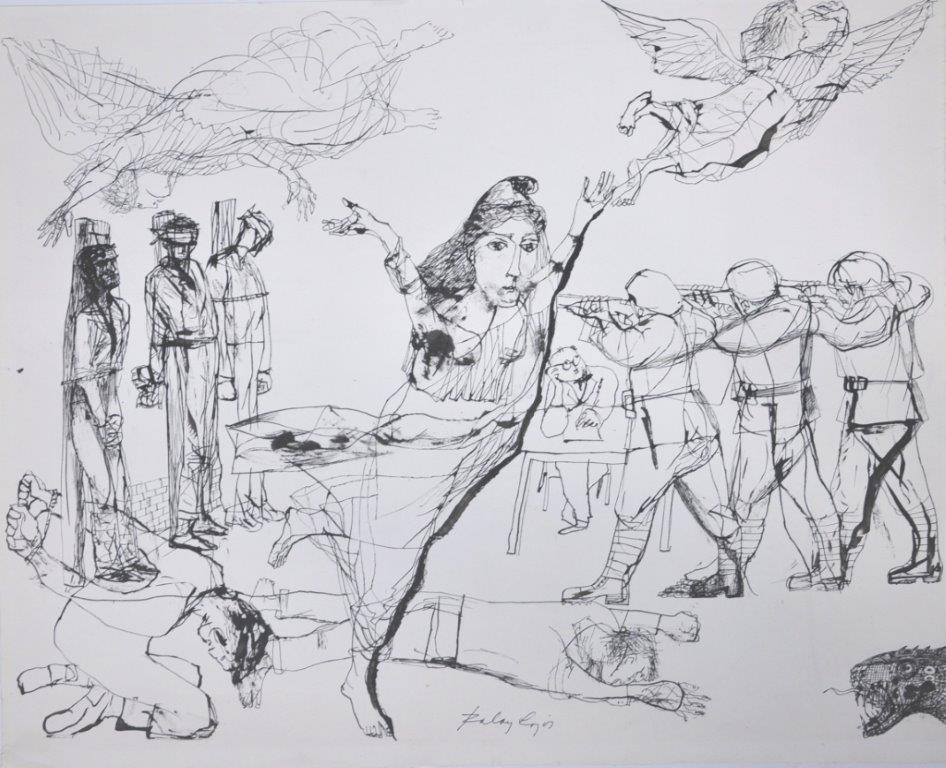Research & Studies

Venue: Műcsarnok (MMA) Budapest H-1076 Dózsa György út 37
Opening ceremony: 6 pm 18. October 2018
Opening by: Géza Boros art historian
György Sümegi: PICTURES OF 1956 – FROM THE OUTSIDE
Works by Hungarian emigré artists on ’56
The exhibition shows a selection of the art created by the Hungarian diaspora on 1956. The works on display here immortalise the events of the 1956 uprising, its locations, participants, spirit and memory. What they have in common is that they were all made in the Kádár era (1956–1989/90) by artists who left the country either during or after the event.
Some works of art that found their way abroad during the fourth (1944-1947), and especially the fifth (1956) great wave of emigration from Hungary were made in the artists’ homeland, and taken out of the country by their creators. The majority, however, were created abroad in the free world, unfettered by fear and censorship. The Kádár regime labelled the events of 1956 a counter-revolution, prohibiting and indeed punishing any positive references to the uprising. László Cs. Szabó described the period following the crushing of the revolution as a “Soviet military nightmare”, “new Stalinism”, and “another Bach era” (a reference to the period of neo-absolutist Austrian rule in the second half of the 19th century). “A new Bach era has befallen Hungary; the third one, and the most bloody for the intellectuals. (…) Hungarians have become strange, two-headed monsters. One head is worn in their homeland, and is called the Counter-Revolutionary; the other is worn in the West, and its name is Witness. They stand with one head before ad-hoc tribunals, and with the other before joint committees; one is being prepared for the scaffold, the other regurgitates its heroic deeds through an interpreter. The Counter-Revolutionary and the Witness were, of course, one and the same person in October 1956.”The artist witnesses who emigrated to the West had the ability to invoke the revolution credibly using a visual language.
Some of the artists who left for the West took their works inspired by their direct experience of the revolution with them to their adopted countries, and later created new ones in response to the inner drive to express what they had been through and how it had affected them emotionally. There were also those who made drawings “in transit”, at the waypoints of the emigration trail, and most of these works are faithful reflections of the situation and emotional state of the refugee (Éva Nagy, Péter Prokop). Gyula Marosán – like many others – was already in his new country when he used the medium of art to discuss his own emigration and that of his wife, and created all the pictures (photomontages, paintings and many series of drawings) that served as a record of the events that he experienced (or were communicated by descriptions and photographs) in the revolution. The works of “56-er artists” (a term coined by Géza Mihályi) who had started or continued their fine-art studies in the West were mostly presented at exhibitions and, in parallel with this, in the media. On the anniversaries of the revolution, the Hungarian-language press and various events and programmes (from concerts held to commemorate the revolution, to the VIT) needed visual works invoking the events of that period. Records show that all of the artists listed below created works inspired by ‘56, but we are only able to exhibit pieces by those shown in italic script: Győző Ambrus, József Ács, László Ács, (?) Áldor, Endre Bálint, Zoltán Balogh, András Beck, Sándor Bodó, Zoltán Borbereki Kovács, Alpár Bujdosó, Lajos T. Csizmadia, Ferenc Daday, Tibor Danielfy, Mária Darázs, Ferenc Deéd, Árpád Domján, József Domján, József Domokos, Sándor Domokos, Zoltán Fényes, Ferenc Fiedler, Gordon György, József Gudics, Zoltán Herpai, Emma Homoródi, Ferenc Horváth, Ferenc Jánossy, József Jakovits, Antal Jancsek,Dávid Mária Kiss, István Juharos, Pál László Kiss, János Antal Kazinczy, László Klaudinyi, Mihály Korcsmáros, Kálmán Kovács, Antal Lux, Kamill Major, Gyula Marosán, Andor Mészáros, Hugó Matzenauer, János Megyik, Géza Metykó , Éva Nagy, István Pázmándy, János Péntek, Ferenc Pintér, Péter Prokop, Richárd Rapaich, Barna Sartory, László Schwalm, Gyula Szalay, Lajos Szalay, Lajos Szathmáry, Ernő Szegedi, Vilmos Szőts, Pál Takács, Gábor Terbots, Anna Tölgyesy, Pál Török, Olga Várady.